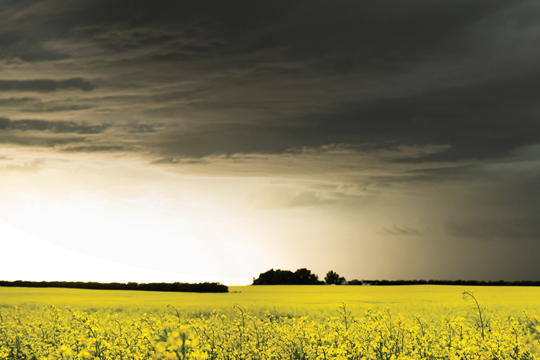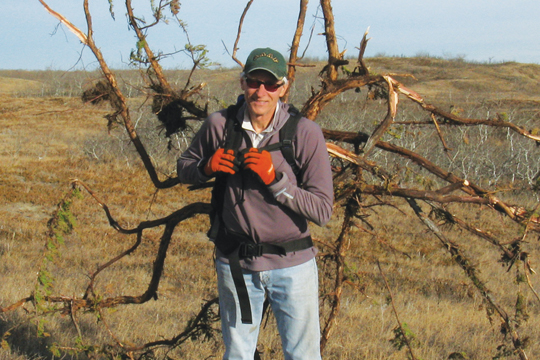
Climate change threatens aspects of Prairie life, but the people have a long history of urgent innovation.
Many things grow quickly and richly on the Canadian Prairies, but an acceptance of climate change has not been among them.
“The Prairies are actually a hotspot for climate change, second to the North in terms of the changes in climate that are projected to occur,” says Jo-Ellen Parry, of the Winnipeg-based International Institute for Sustainable Development (IISD). “And yet, the global action and planning on the Prairies is lower than in British Columbia, or in the Atlantic provinces. I think there's a variety of reasons for that.”
Those reasons include a self-assuredness that people of the Prairies can manage climate challenges on land that’s long familiar with weather extremes, says Parry, who is IISD’s director of adaptation in Canada.
“It goes down to -30 [Celsius] in the winter, and it goes up to +30 in the summer, and that's a fairly wide temperature range,” she says. The region also naturally “oscillates between being too wet and being too dry,” a natural variability that can obscure “the underlying process of warming.”
Yet there’s a growing acceptance that the climate is changing in the Prairie provinces of Manitoba, Saskatchewan and Alberta, as significant drought and “one-in-a-100-years flood events” become more frequent, while smoke from massive forest fires in B.C. has been visible as far east as Winnipeg.
An urgent example of heightened awareness on the Prairies can be found in a report from the Métis National Council.
“Métis peoples living in Western Canada are uniquely sensitive to the impacts of climate change due to their dependence on the land for their identity, culture, livelihoods and resource-dependent economies,” reads the 2020 report, which also alludes to a particular strength of the region — historic adaptability.
“Over many generations, Métis have found innovative ways to live in their particular environment despite diminished access to land and waters… Their knowledge can support adaptation solutions as they are developed for Indigenous and non-Indigenous populations.”
Such a record of resiliency is fundamental to Prairie life, nowhere more than in the vast agricultural sector.
“More than 80 per cent of all the farmland in Canada is in the Prairie provinces,” says David Sauchyn, a professor of geography and environmental science and director of the Prairie Adaptation Research Collaborative at the University of Regina.
“That’s the sector that's most likely to be impacted, but it's also the sector that is the most adaptable. Agriculture was imported to the Prairies about 140 years ago, and there was serious adaptation required to sustain agriculture in this region.”
It may seem counter-intuitive, but while the Prairies have “fantastic soil” for growing, they also have “a fairly harsh climate” with a relatively short growing season,” and “a permanent water deficit.” Essential to water supplies is snow that, historically, has melted slowly in spring and been absorbed into the freshly thawed ground.

David Sauchyn, a professor of geography and environmental science, reconstructs climate from tree rings. Here, he excavated a shrub to examine and carried it out from the trail on his back.
“If it wasn't for the snow, we would be in serious trouble,” Sauchyn says, “and the problem with climate change is our snowpack will eventually dwindle and disappear, given enough warming.”
Snow that does fall is melting earlier and not being absorbed into ground that remains stubbornly frozen. On the other side of the seasonal coin, more rain is expected to fall in increasingly heavy incidents, and then run off dry ground instead of being absorbed. “You can actually get more precipitation, but have drier conditions.”
There are worsening droughts, such as the “horrible” summer of 2021 — though, he notes, crop losses were lower in 2021 than they were in the famously dry 1930s, even though it was drier in 2021.
“There's been a whole lot of adaptation to enable the level of agricultural productivity that we enjoy today,” he says. “There's been so much improvement in technology and farming practices and crop breeding and so on, we're able to sustain agriculture now through exceedingly dry summers.”
The issues are deep-rooted, literally. Much current research studies what crops will be suitable to be grown on the Prairies in future — how canola, pulses and, of course, wheat will fare, and what new varieties or crops may become more suited to the changed climate.
Such studies benefit from the innate strength of the quicker response allowed by working on an annual crop cycle, Sauchyn says. Also, the vast majority of farms, which are family-owned, do not have to report to and await direction from a corporate structure. “The CEO is usually in the kitchen.”
Despite these strengths, the challenges are massive, and co-operation at all levels is urgently needed. Sauchyn’s data show water levels on the Prairies going back to AD as in AD 888, and he says, “there have been droughts that are way more wicked than anything that's occurred since the Prairies were settled by my grandparents and other people. These droughts will reoccur, but when they do, it'll be in a warmer climate. That's where you've exceeded the capacity of individual farms to deal with climate change, and more governments have to step in.”
Protecting people
Governments of the provinces are working together through Climate West, with an aim to protect people and communities, ecosystems and the organisms that live in them. They also want to mitigate the enormous costs of acting too late.
“One of the things we're interested in,” says Climate West executive director Kerra Chomlak, who’s based in Leduc, Alta., “is the cost of climate change — what kind of costs are we going to see in our economy, and why we might want to take action early to avoid more costs, because these things become more extreme and more costly over time.”
Elaine Fox, who is board chair and the Manitoba government’s representative on Climate West, says that in addition to agriculture, climate change has impacts on “industry, supply lines, on our wildlife or fisheries, on people in vulnerable populations that are within our urban centres, but also smaller communities that haven't been able to do a lot of that physical infrastructure adaptation ahead of time.”
As an example, she cites forest fires, which are increasing in frequency and severity, and expanding from remote northern areas to more populated southern areas. As a CBC headline warned in 2019, forest fires are “Earlier, later, and less predictable.”
“You might not be able to avoid the wildfire, but maybe you can avoid being evacuated,” says Fox, who mentions potential measures such as SMART fire programs, or the traditional Indigenous practice of controlled burns, along with generally improved forest-management practices to survive in an age of drier forests and more lightning strikes from increasingly frequent and heavy storms.
Threats to the boreal forest that spans the northern regions of the three provinces include the expanding range of the pine beetle, and the unusual appearance of oak or ash hardwood trees that don’t provide food for indigenous creatures, and present challenges to the softwood lumber industry.
More research is under way into the climate challenges faced by wildlife large and small — from the famous polar bears of northern Manitoba that are struggling with declining sea ice, to the schedules of migrating songbirds and the insects they eat, which may become disastrously disjointed.
Fish, and fishing, are also at risk. In Lake Winnipeg, for example, fishing is booming as warmer waters encourage the growth of algae, a key food source for many fish — until there’s so much algae that oxygen is depleted and fish die. “It's a hard one to say that it's actually been detrimental,” Fox says. “It’s on its way to being detrimental, but it's not there yet.”
Infrastructure challenges
Given the vast breadth of the Prairie landscape — Saskatchewan alone has approximately 250,000 kilometres of roads, more than any other Canadian province — transportation is an acute issue as organizations study what people drive in, and what they drive on. The issues are complex.
“We don't have significant infrastructure in our province to allow people the accessibility to live their lives without the reliance on a vehicle,” says Bethany Daman, communications manager with Manitoba’s Climate Action Team (MCAT). “We don't have proper inter-community transport as far as communities outside of urban centres, and even within urban centres.”
MCAT is advising government on “all of those things that help reduce the number of vehicles on the road,” and how to ensure that essential vehicles are electric. “The charging infrastructure needs to be increased significantly, because that's a huge barrier for people right now,” Daman says.
There’s also an entire system of seasonal winter roads that are crucial to life in northern regions and are being undone by warmer winters. Jo-Ellen Parry says the IISD is among those studying “the lack of capacity of communities to bring in the heavy equipment and heavy construction materials they will require (and) our severe inability to bring in sufficient amounts of fuel.” Flying in essential supplies would increase costs tremendously.
Like so much else, the state of ice roads remains unpredictable from one year to the next. “The hallmark of climate change really is unpredictability,” Parry says.
One certainty is the need for people, communities and governments to change their approach to how so much is done.
“Adaptation,” Sauchyn says, “is changing our technologies, our policies, our programs, our infrastructure, our urban planning and our behaviour in response to climate change, and in anticipation of further climate change. It's basically changing just about everything we do, so we are less vulnerable to the changing climate.”
That Prairie resiliency has never been more important. As Elaine Fox says, “We've been very good at adaptation over the last year century.”

